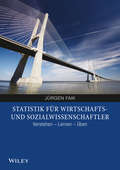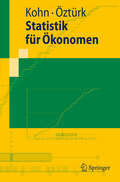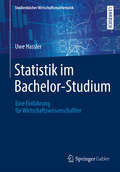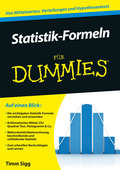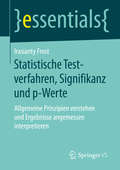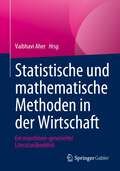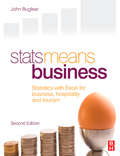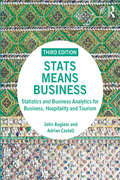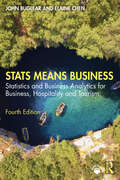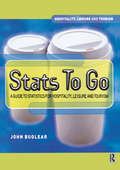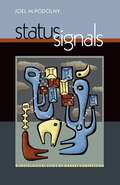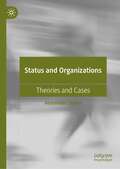- Table View
- List View
Statistik für Wirtschafts- und Sozialwissenschaftler: Verstehen, Lernen, Üben
by Jürgen FaikStatistik ist ein komplexes Thema, aber es muss nicht unbedingt kompliziert erklärt werden. Jürgen Faik bringt Ihnen in diesem Buch die Statistik so verständlich wie möglich näher. Er führt Sie erst in die statistischen Grundlagen ein und widmet sich dann der deskriptiven Statistik. Hier lernen Sie, was zu Häufigkeitsverteilungen, Verhältnis- und Indexzahlen und Zeitreihenanalysen wichtig zu wissen ist. Im nächsten Teil wird die induktive Statistik besprochen. Der Autor beginnt mit den Grundlagen der Wahrscheinlichkeitsrechnung und fährt mit Zufallsvariablen, diskreten und stetigen Verteilungen, Schätz- und Testtheorie fort. Eine knappe Einführung in die Ökonometrie schließt das Buch ab. Zahlreiche Übungsaufgaben mit Lösungen helfen Ihnen, Ihr Wissen zu testen und zu festigen.
Statistik für Ökonomen
by Riza Öztürk Wolfgang KohnDie Autoren erläutern in einer anschaulichen, anwendungsorientierten und kompakten Darstellung alle elementaren statistischen Verfahren, die in der Ökonomie angewendet werden - ergänzt durch zahlreiche Beispiele und Übungen. Der Text enthält Programmanweisungen sowohl für das Statistikprogramm R (Open-Source-Progamm) als auch für SPSS. Das Buch richtet sich an Studierende, die sich in wirtschaftswissenschaftlich ausgerichteten Studiengängen mit Statistik beschäftigen.
Statistik für Ökonomen: Datenanalyse mit R und SPSS
by Riza Öztürk Wolfgang KohnIn diesem anwendungsorientierten Lehrbuch werden kompakt alle elementaren statistischen Verfahren für die Ökonomie anschaulich erklärt. Der leicht verständliche Text ist mit vielen Beispielen und Übungen ergänzt. Die praxisnahe Darstellung der Methoden wird durch die Erklärung und Anwendung der Statistikprogramme R (Open-Source-Progamm) und SPSS vervollständigt. Im Text sind für beide Programme viele Programmanweisungen enthalten. Zielgruppe sind insbesondere wirtschaftswissenschaftlich orientierte Studierende.Für die 4. Auflage wurde das Buch überarbeitet und ergänzt. Leser des gedruckten Buchs erhalten nun in der Springer Nature Flashcards-App zusätzlich kostenfreien Zugriff auf 99 exklusive Lernfragen, mit denen sie ihr Wissen überprüfen können.
Statistik im Bachelor-Studium: Eine Einführung Für Wirtschaftswissenschaftler (Studienbücher Wirtschaftsmathematik Ser.)
by Uwe HasslerDieses Buch umfasst genau den Stoff, der typischerweise in Klausuren zu Einführungsvorlesungen "Statistik" an wirtschaftswissenschaftlichen Fachbereichen abgeprüft wird. Es enthält mehr als 100 ehemalige Klausuraufgaben mit Lösungen auf der Verlagsseite, die das Klausurtraining erleichtern sollen. Weiterhin finden sich über 60 vollständig durchgerechnete und ausformulierte Beispiele und Fallstudien.
Statistik in Deutschland
by Walter Krämer Heinz Grohmann Almut StegerDer Band bietet eine allgemein verständliche Übersicht über 100 Jahre Deutsche Statistische Gesellschaft (DStatG). In 17 Kapiteln schildern anerkannte Experten, wie die DStatG zur Begründung und Fortentwicklung der deutschen Wirtschafts- und Sozialstatistik und zu methodischen Innovationen wie neuere Zeitreihen-, Preisindex- oder Stichprobenverfahren beigetragen hat. Weitere Themen sind die Rolle der DStatG bei der Zusammenführung der Ost- und Weststatistik sowie die Vorbereitung und Durchführung der letzen und der aktuellen Volkszählung.
Statistik mit SPSS Alles in einem Band für Dummies (Für Dummies)
by Jürgen FaikReale Sachverhalte statistisch zu erschließen und zu analysieren ist eine hohe Kunst. Das Programmpaket SPSS ist dafür ein mächtiges Werkzeug. In diesem Buch lernen Sie anhand zahlreicher Beispiele, welche statistischen Verfahren es überhaupt gibt und wann welches Verfahren angemessen ist. Gleich im Anschluss erfahren Sie, wie diese Verfahren in SPSS implementiert sind und wie Sie sie in Ihrem Fachgebiet nutzen können. So finden Sie Zusammenhänge in Ihren Daten, die statistisch signifikant sind.
Statistik mit „R“ für Nicht-Mathematiker: Praktische Tipps für die quantitativ-empirische Bachelor-, Master- und Doktorarbeit (essentials)
by Karl-Heinz FittkauDas Schreiben einer quantitativ-empirischen Graduierungsarbeit ist wie das Kochen in einer Mensa. Es sollte schnell gehen, das Essen schmecken, gesund und kostengünstig sein. Um das zu erreichen, müssen Rezepte eingehalten werden. Ohne Leidenschaft, aber professionell. Dieses essential gibt Ihnen solche Rezepte an die Hand, die Sie nur nachkochen müssen. Wie ist eine solche Arbeit aufgebaut? Wie formuliere ich Hypothesen und wie überprüfe ich diese korrekt? Es wird der Umgang mit der kostenfreien Statistiksoftware „R“ erklärt. Die benötigte Syntax finden Sie im essential. Sie müssen sie lediglich kopieren.
Statistik-Formeln für Dummies (Für Dummies)
by Timm SiggStatistisch gesehen sind 30% der Studenten schon mal durch eine Statistik-Klausur gefallen. Das kann Ihnen mit diesem handlichen Buch nicht passieren. Es ist das perfekte Nachschlagewerk für die Hosentasche und enthält alle wichtigen Begriffe und Formeln der Statistik, die Sie benötigen, ganz egal, ob Sie Psychologie studieren oder in einer Bank Risikomanager sind. Und damit Sie auch verstehen, wozu die Formeln gut sind, liefert Timm Sigg zu jeder Formel auch gleich noch ein anschauliches Beispiel mit, in dem Sie die Anwendung der Formel sehen und verstehen können.
Statistische Hypothesentests: Bausteine der Künstlichen Intelligenz (essentials)
by Siegfried WeinmannDieses Essential führt über die formale Methode des statistischen Entscheidens hinaus und klärt die Frage, mit welcher Gewissheit der Ausgang eines Tests ein Problem lösen kann. Wer sich in kurzer Zeit ein Grundverständnis der Beurteilenden Statistik erwerben will, kommt an diesem Buch nicht vorbei. Es setzt am Ursprung der Stichprobentheorie an, erklärt die Bayes-Evidenzmaße des Hypothesentests und diskutiert ihre Wirksamkeit an allgemeingültigen Fällen. Der Stoff des Essentials bildet einen wissenschaftlichen Pfad zur Künstlichen Intelligenz, der dem Leser in origineller Weise den objektorientierten Entwurf eines künstlichen Entscheidungsagenten darlegt und Einblicke in den Bau von Softwarekomponenten bietet.
Statistische Testverfahren, Signifikanz und p-Werte: Allgemeine Prinzipien verstehen und Ergebnisse angemessen interpretieren (essentials)
by Irasianty FrostDieses essential erklärt das grundlegende Prinzip statistischer Testverfahren. Dabei stehen die Bedeutung der statistischen Signifikanz sowie des p-Wertes im Fokus. Häufig anzutreffende Fehlinterpretationen werden angesprochen. Dadurch wird ersichtlich, was ein signifikantes Ergebnis aussagt und, was es nicht aussagt. Der Leser wird somit befähigt, adäquat mit Testergebnissen umzugehen.
Statistische und mathematische Methoden in der Wirtschaft: Ein maschinen-generierter Literaturüberblick
by Vaibhavi AherDieses Buch vermittelt Wissen über die statistischen und mathematischen Methoden in der Wirtschaft und beinhaltet die Themenschwerpunkte Analyse, Schätzung und Vorhersage. In jedem Kapitel gibt es ein breites Spektrum an Forschungsarbeiten, die einen Einblick über das Thema geben sowie Beispiele für die Anwendung der Ökonometrie in realen Situationen. Das Buch enthält einen systematischen Literaturüberblick auf der Grundlage maschinell generierter Inhalte. Fragen und zugehörige Schlüsselwörter wurden für die Maschine vorbereitet, die sie abgefragt, entdeckt, zusammengestellt und durch Clustering mit künstlicher Intelligenz (KI) strukturiert hat. Springer Nature hat in den letzten Jahren viel zu dem Thema in Zeitschriften veröffentlicht, so dass die Herausforderung für die Maschine darin bestand, die relevantesten Inhalte zu identifizieren und sie in einer strukturierten Weise zu präsentieren. Die automatisch generierten Literaturzusammenfassungen dienen Wissenschaftlern und Studenten, um sich einen Überblick über die aktuelle Entwicklung des Themas zu verschaffen und Forschungsfragen zu entwickeln, aber auch Personen aus der Praxis erhalten Anregungen und Impulse.
Statoil: Transparency on Payments to Governments
by Paul M. Healy George Serafeim Jerome LenhardtCase
Stats Means Business: A Guide To Business Statistics
by John Buglear'Stats Means Business' is an introductory textbook aimed at Business Studies students who require guidance in the area of statistics. It minimizes technical language, provides clear definition of key terms, and gives emphasis to interpretation rather than technique. 'Stats Means Business' enables readers to:* appreciate the importance of statistical analysis in business* understand statistical techniques* develop judgment in the selection of appropriate statistical techniques* interpret the results of statistical analysisThere is an overwhelming need for successful managers to be able to deal competently with numerical information and this text is developed with this in mind by providing worked examples and review questions which are rooted in viable business contexts.Each chapter includes guidance on using Excel and Minitab to produce the analysis described and explained in the chapter. The start of every chapter identifies aims and summarizes content and each is written in an accessible style. Model solutions are provided for three problems in each chapter and further solutions are available on a web site to accompany the book.The book is suitable for first year undergraduate courses, MBA Programmes and anyone who needs support and guidance in the area of statistics.
Stats Means Business: A Guide To Business Statistics
by John Buglear'Stats Means Business' is an introductory textbook aimed at Business Studies students who require guidance in the area of statistics. It minimizes technical language, provides clear definition of key terms, and gives emphasis to interpretation rather than technique. 'Stats Means Business' enables readers to:* appreciate the importance of statistical analysis in business* understand statistical techniques* develop judgment in the selection of appropriate statistical techniques* interpret the results of statistical analysisThere is an overwhelming need for successful managers to be able to deal competently with numerical information and this text is developed with this in mind by providing worked examples and review questions which are rooted in viable business contexts.Each chapter includes guidance on using Excel and Minitab to produce the analysis described and explained in the chapter. The start of every chapter identifies aims and summarizes content and each is written in an accessible style. Model solutions are provided for three problems in each chapter and further solutions are available on a web site to accompany the book.The book is suitable for first year undergraduate courses, MBA Programmes and anyone who needs support and guidance in the area of statistics.
Stats Means Business: Statistics and Business Analytics for Business, Hospitality and Tourism
by John Buglear Adrian CastellStats Means Business is an introductory and comprehensive textbook written especially for Hospitality, Business and Tourism students who take statistics or quantitative methods modules. By minimising technical language, providing clear definitions of key terms and giving emphasis to interpretation rather than technique, this book caters to beginners in the subject. This book enables readers to appreciate the importance of statistical analysis in hospitality, tourism and other fields of business, understand statistical techniques, develop judgement in the selection of appropriate statistical techniques and interpret the results of statistical analysis. This new edition has been fully revised and updated to include: New content on business analytics Case studies demonstrating practical applications An extensive selection of new self-test questions Stats Means Business is an ideal, accessible and practical introduction to statistics and quantitative research methods for Hospitality, Business and Tourism students. Visit the companion website at www.routledge.com/cw/buglear for bonus teaching and learning resources.
Stats Means Business: Statistics and Business Analytics for Business, Hospitality and Tourism
by John Buglear Elaine ChenStats Means Business is an introductory and comprehensive textbook written especially for hospitality, business and tourism students who take statistics or quantitative methods modules. By minimising technical language, providing clear definitions of key terms and giving emphasis to interpretation rather than technique, this book caters to beginners in the subject.This book enables readers to appreciate the importance of statistical analysis in hospitality, tourism and other fields of business, understand statistical techniques, develop judgement in the selection of appropriate statistical techniques and interpret the results of statistical analysis.This new edition has been fully revised and updated to include: New content on business analytics Case studies demonstrating practical applications An extensive selection of new self-test questions Updated online teaching and learning resources Stats Means Business is an ideal, accessible and practical introduction to statistics and quantitative research methods for hospitality, business and tourism students.
Stats To Go
by John Buglear'Stats to Go' is a user-friendly guide for hospitality, leisure and tourism students who need to learn statistics and statistical techniques. 'Stats to go' is an ideal companion to hospitality, leisure and tourism studies as the breadth of coverage supports all taught numerical aspects of these types of course. Examples from hospitality, leisure and tourism organizations: * licensed premises* fast food outlets* hotels * theme parksand their environments are used to illustrate key issues of the text.The area of quantitative methods is one which many students find unapproachable or daunting. With the use of a clear learning structure, and a user friendly, non-theoretical approach, Buglear has created a text which students and lecturers alike will find indispensable.
Stats and Curiosities
by Harvard Business ReviewFascinating stats... useful tips... entertaining topics.Did you know that to make a task seem easier, all you have to do is lean back a little? Or that retail salespeople who mimic the way their customers speak and behave end up selling more?If you like stats like this, are intrigued by ideas, and find connecting the dots to be a critical part of your skill set-this book is for you.Culled from Harvard Business Review's popular newsletter, The Daily Stat, this book offers a compelling look at insights that both amuse and inform. Covering such managerial topics as teams, marketing, workplace psychology, and leadership, you'll find a wide range of business statistics and general curiosities and oddities about professional life that will add an element of trivia and humor to your learning (and will make you appear smarter than your colleagues).Highly quotable and surprisingly useful, Stats and Curiosities: From Harvard Business Review will keep you on the front lines of business research-and ahead of the pack at work.
Status Anxiety: Hong Kong's Crisis of Identity
by Bruce VonCannonIn this book, retired banking CEO Bruce VonCannon considers the past, present and future of Hong Kong, the dynamic finance-driven autonomous city that is beset by global issues- US–China tension, income inequality, housing scarcity, climate change- within the microcosm of a small island archipelago and a hyper-specific local culture. The Hong Kong Special Administrative Region is today one of the world’s foremost economic and financial hubs and a repository for 18% of the world’s stored wealth, home to the region’s most vibrant stock market, a major free trade port city and traditional gateway to mainland China, the world’s 2nd largest economy. The recent street protests which broke out in June 2019 have been described as a pro-democracy movement. However, other analysts disagree and argue that the street protests have more in common with the populist movements springing up in other parts of the world as the result of a growing divide between rich and poor. This book delves into financial realities, Hong Kong's position within the new global competition between China and the United States, and as a model for the urbanization of the future.
Status Signals: A Sociological Study of Market Competition
by Joel M. PodolnyWhy are elite jewelers reluctant to sell turquoise, despite strong demand? Why did leading investment bankers shun junk bonds for years, despite potential profits? Status Signals is the first major sociological examination of how concerns about status affect market competition. Starting from the basic premise that status pervades the ties producers form in the marketplace, Joel Podolny shows how anxieties about status influence whom a producer does (or does not) accept as a partner, the price a producer can charge, the ease with which a producer enters a market, how the producer's inventions are received, and, ultimately, the market segments the producer can (and should) enter. To achieve desired status, firms must offer more than strong past performance and product quality--they must also send out and manage social and cultural signals. Through detailed analyses of market competition across a broad array of industries--including investment banking, wine, semiconductors, shipping, and venture capital--Podolny demonstrates the pervasive impact of status. Along the way, he shows how corporate strategists, tempted by the profits of a market that would negatively affect their status, consider not only whether to enter the market but also whether they can alter the public's perception of the market. Podolny also examines the different ways in which a firm can have status. Wal-Mart, for example, has low status among the rich as a place to shop, but high status among the rich as a place to invest. Status Signals provides a systematic understanding of market dynamics that have--until now--not been fully appreciated.
Status and Organizations: Theories and Cases
by Alexander StyhreThis book examines social status as a social mechanism and a social fact that strongly shapes how markets and organizations are regulated, managed, and preserved over time. The first part of this book identifies a number of organizational issues and managerial concerns that can be framed as being a matter of the cognitive perspectives of social actors, and better explained on the basis of such conditions. The second part demonstrates the analytical value of the concept of status in a variety of organizational settings and market contexts. In the three empirical settings, status does play a key role when resources such as legitimacy (in urban development projects), revenues from sales (in video game marketing), and access to venture capital (in life science companies) are distributed. This book summarizes and reviews the academic literature on status and organization studies, as well as providing valuable information for researchers conducting empirical testing. It will be of great interest to students and scholars of Organizations and Social Systems.
Status and the Rise of Brazil: Global Ambitions, Humanitarian Engagement and International Challenges
by Maria Gabrielsen Jumbert Benjamin De Carvalho Paulo EstevesThis book explores the evolution of Brazilian foreign relations in the last fifteen years, with a focus on continuities and change. The volume tackles three sets of themes: diplomacy and diplomatic culture, international security and international development cooperation. Central to these themes is how they all relate to Brazil’s international status, and its quest for higher standing. The authors draw on a wide variety of methodologies to grapple with the subject matter, from diplomatic history to international sociology and postcolonial studies. The result is a combination of different approaches that seek to account for the foreign relations of Brazil.
Status in Management and Organizations
by Jone L. PearcePeople go to extraordinary lengths to gain and defend their status. Those with higher status are listened to more, receive more deference from others, and are perceived as having more power. People with higher status also tend to have better health and longevity. In short, status matters. Despite the importance of status, particularly in the workplace, it has received comparatively little attention from management scholars. It is only relatively recently that they have turned their attention to the powerful role that social status plays in organizations. This book brings together this important work, showing why we should distinguish status from power, hierarchy and work quality. It also shows how a better understanding of status can be used to address problems in a number of different areas, including strategic acquisitions, the development of innovations, new venture funding, executive compensation, discrimination, and team diversity effects.
Status of Climate Change Adaptation in Asia and the Pacific (Springer Climate)
by Mozaharul Alam Jeongho Lee Puja SawhneyThis volume provides an overview of the climate change adaptation objectives set, actions taken, and challenges faced by several countries in the Asia-Pacific region. The majority of the populations in this region struggle to make a living from subsistence agriculture, and livelihoods are highly dependent on natural ecosystem services which are likely to be severely affected by climate change. Cases discussed in this book highlight successes made by governments towards achieving adaptation objectives, and efforts required to overcome challenges. While significant economic advances have been made, the pace of growth has been slow to impact the lives of a majority of the people who live below the poverty line. The chapters highlight adaptation actions for protecting people and their livelihoods in priority sectors, maintaining food and water security, supporting socio-economic stability including poverty reduction, and climate risk management. This book also maximizes readers' insights into the knowledge gaps and limitations of stated adaptation goals, and the bottlenecks that hinder implementation in different regions.
Statutes in Court: The History and Theory of Statutory Interpretation
by William D. PopkinHow do judges determine the meaning of laws? The extent to which judges should exercise their discretion in interpreting legislation has been a contentious issue throughout American history, involving questions about the balance of power between the legislature and the judiciary. In Statutes in Court William D. Popkin provides an indispensable survey of the history of American statutory interpretation and then offers his own theory of "ordinary judging" that defines the proper scope of judicial discretion. Popkin begins by discussing the British origins of statutory interpretation in this country. He then maps the evolving conceptions of the judicial role in the United States from Revolutionary times through the twentieth century before presenting his "ordinary judging" theory--one that asks the judge to use modest judicial discretion to assist the legislature in implementing good government. Claiming that theory cannot account for everything a judge does when determining statutory meaning or writing an opinion, Popkin shows how judges who strive to be conscientious in interpreting the law are often hampered by the lack of both a framework in which to fit their approach and a well-understood common vocabulary to explain what they do. Statutes in Court fills that gap. This work will be valuable to anyone concerned about the judicial role in the interpretation of laws--from judiciary officials and law professors to legal historians and political scientists.
